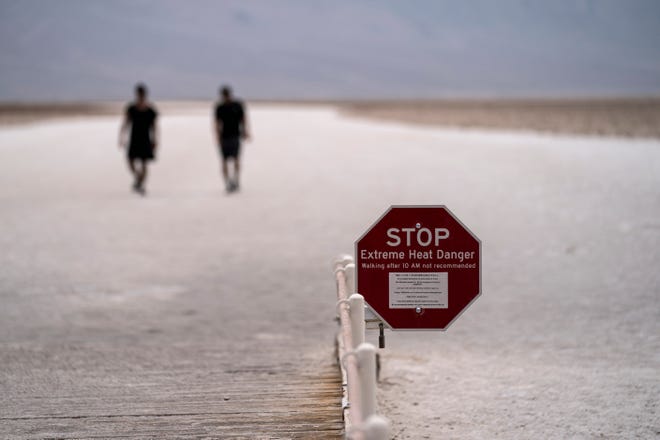
- The heat is straining power grids and fueling wildfires across almost 500 square miles.
- Heat warnings have been in effect for almost a week across much of the Southwest.
- Daily records were broken Saturday across California, Nevada and Arizona.
The record-breaking heat across much of the West was easing somewhat Monday, but a "heat dome" means temperatures could remain well above average highs all week, forecasters say.
The weather setup is similar to what the region saw two weeks ago, when extreme heat sweeping across the Pacific Northwest and western Canada broke records and fueled devastating wildfires.
"This time, the core of the high pressure and heat has been anchored farther to the south and has allowed excessive heat to build up across the region," AccuWeather Senior Meteorologist Adam Douty said.
The heat is straining power grids and fueling wildfires across almost 500 square miles – the size of the city of Los Angeles – in six Western states.
The largest blaze, the Bootleg Fire, burned across more than 220 square miles in Oregon and was 0% contained. In California, residents were asked to immediately reduce power consumption after fire knocked out interstate power lines, preventing up to 5,500 megawatts of electricity from flowing into the state.
Western wildfires: Over 300K acres burned across 6 states; 2 firefighters dead

Heat warnings have been in effect for almost a week across much of the Southwest. Douty said that, while the peak of the heat has passed for places such as Death Valley and Las Vegas, temperatures will remain 5 to 15 degrees above normal through much of the week.
Daily records were broken Saturday across California, Nevada and Arizona, and extreme heat extended into Idaho and the interior parts of the Pacific Northwest. Accuweather expects the temperature in Death Valley to reach 127 degrees Monday, just shy of the area's daily record high of 129. The world record high is 134 degrees.
St. George, Utah, reportedly reached 117 degrees Friday. If confirmed, that would tie for the hottest day on record for the entire state. Las Vegas also set a new daily record-high temperature on Friday of 116, then broke a different record Saturday.
"#LasVegas went from record-breaking heat yesterday, to record-breaking rainfall today," the National Weather Service in Las Vegas tweeted late Saturday, saying the 0.1 inches of rain "measured at McCarran International Airport is the most rain that Las Vegas has received on any July 11th since records began in 1937."
Blame the heat dome. A heat dome is the result of a strong change in ocean temperatures from west to east in the tropical Pacific Ocean during the preceding winter, according to the National Ocean Service. The warm air coming from the west part of the Pacific Ocean then gets trapped in the jet stream as it approaches land.
When that hot air arrives over land, the atmosphere traps the hot air as if a lid was put on it. Winds can move the heat dome around, hence it is also referred to as a heat wave.
And the impact on wildfires can be deadly. Two Arizona firefighters died after a plane responding to a wildfire in the state crashed on Saturday afternoon, according to the federal Bureau of Land Management. The Cedar Story Basin Fire was 700 acres and was 0% contained.
Late Saturday, flames jumped U.S. 395, which was closed near the small town of Doyle in California’s Lassen County. The lanes reopened Sunday – with a strong warning to motorists.
“Do not stop and take pictures,” the fire’s Operations Section Chief Jake Cagle said. “You are going to impede our operations if you stop and look at what’s going on.”
All this after last month checked out as the hottest June across the nation on record, according to a report released Friday by the National Oceanic and Atmospheric Administration. And with the heat comes drought. Extreme to exceptional drought conditions are affecting vast swaths of California, Nevada and Arizona, according to the United States Drought Monitor.
Contributing: Elinor Aspegren, USA TODAY
It's bringing record highs to the Pacific Northwest. What is a heat dome?
Relief in sight. For Death Valley? Cooler temps mean 120-125.
Source link







